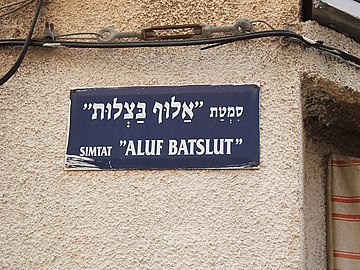ភាសាហេប្រឺ
| ភាសាហេព្រើរ | |
|---|---|
| עִבְרִית ʿIvrit | |
| ការបញ្ចេញសំឡេង | [(ʔ)ivˈʁit] - [(ʔ)ivˈɾit][note ១] |
| ដើមកំណើតនៅ | Israel, Jewish settlements in the West Bank;[១] used globally as a liturgical language for Judaism |
អ្នកនិយាយដើមកំណើត | Expression error: Unrecognized punctuation character "២".[២] |
អាហ្វ្រូ-អាស៊ី
| |
| Hebrew alphabet Hebrew Braille | |
| ស្ថានភាពផ្លូវការ | |
ភាសាផ្លូវការនៅក្នុង | |
ភាសាជនជាតិភាគតិច ត្រូវបានទទួលស្គាល់ | |
| គ្រប់គ្រងដោយ | Academy of the Hebrew Language האקדמיה ללשון העברית (HaAkademia LaLashon HaʿIvrit) |
| កូដភាសា | |
| ISO 639-1 | he |
| ISO 639-2 | heb |
| ISO 639-3 | Either: heb – Modern Hebrew hbo – Ancient Hebrew |
| Linguasphere | 12-AAB-a |

ភាសាហេព្រេីរឬហេប្រ៊ូ (អង់គ្លេស: Hebrew language បារាំង៖ Hébreu ហេព្រេីរ៖ עִבְרִית អីវ្រីត ) គឺជាភាសាសេមិតិក់Semitic language. It is the language of the Jews. the Academy of the Hebrew Language is the supreme institution the Hebrew language.
ភាសានេះត្រូវបាននិយាយដោយជនជាតិអ៊ីស្រាអែលជាយូរយារណាស់មកហើយ តាំងតែពីសម័យនៃព្រះគម្ពីរមកម្ល៉េះ។ After Judah was conquered by Babylonia, the Jews were taken captive to Babylon and started speaking Aramaic. Hebrew was no longer used as much in day-to-day life, but it was still known by Jews who studied religious books.
In the 20th century, many Jews decided to make Hebrew into a spoken language again. តាំងពីឆ្នាំ ១៩៤៨ ភាសាហេព្រេីរជាភាសាផ្លូវការនៅក្នុងប្រទេសអីស្រាអែលនិងមានលោកច្រេីនដែលមកពីប្រទេសផ្សិងៗមកដល់ប្រទេសនោះនិងបានរៀនភាសាហេព្រេីរដេីម្បីនិយាយជាមួយគ្នា។
Also everyone who wishes to become a Christian priest must learn Hebrew in order to be able to read the Bible in original language.[ប្រភព?]
ភាសាហេព្រេីរជាជាតិភាសាអារាប់។ Hebrew words are made by combining a root with a pattern. In Israeli Hebrew, some words are translated from European languages like English, French, German, and Russian. Many words from the Old Testament were given new meanings in Israeli Hebrew. People learning Hebrew need to study the grammar first in order to read correctly without vowels. In Israeli Hebrew, there is no verb "to be" in the present tense, only in the future and the past tenses. In Biblical Hebrew, there are no tenses but only two "aspects": imperfect and perfect. The imperfect is something like the future and the present tenses. The perfect is something like the past tense. Mishnaic Hebrew is the Hebrew spoken as well as Judeo-Aramaic in the time of Jesus and in the time of the Bar-Kokhba revolt (2nd century AD), until the Byzantine Empire of Justinian (6th century AD).
អក្សរក្រម
[កែប្រែ]The Hebrew alphabet has 22 letters. Five of these letters change when they are at the end of a word. The Hebrew language is read from right to left. The Hebrew alphabet is an abjad which means that only the consonants are written out and the reader must supply the vowels himself. Since this is pretty difficult, the vowels can be marked as dots called niqqud (plural niqqudim). In Modern Hebrew, some letters can denote vowels. These are called matres lectionis (mothers of the reading) as they help the reading a lot.
| Aleph អាលេហ្វ | Bet បេត | Gimel ហ្គីមេល | Dalet ដាលេត | He ហេ | Waw អួាអូ | Zayin ហ្សាយិន | Het ហេត | Tet តេត | Yod យុដ | Kaf កាហ្វ |
|---|---|---|---|---|---|---|---|---|---|---|
| א | ב | ג | ד | ה | ו | ז | ח | ט | י | כ |
| ך | ||||||||||
| Lamed លាមេដ | Mem មិម | Nun នូន | Samekh សាមេហ | Ayin អាយិន | Pe/Fe ពេ | Tsadi ត្សាដិ | Kuf កុហ្វ | Resh រេឝ | Shin/Sin ឝិន | Tav តាវ |
| ל | מ | נ | ס | ע | פ | צ | ק | ר | ש | ת |
| ם | ן | ף | ץ |
កំណត់ចំណាំ
[កែប្រែ]ឯកសារយោង
[កែប្រែ]| មានសព្វវចនាធិប្បាយសេរី វិគីភីឌា ជាភាសាហេប្រឺ |
| The Wikibook wikibooks: មាន a page បន្ថែមអំពី |
- ↑ "CIA's World Fact Book". Cia.gov. Archived from the original on 2014-07-08. Retrieved 2013-04-25.
- ↑ ទំព័រគំរូ:Ethnologue17
ទំព័រគំរូ:Ethnologue17 - ↑ "ច្បាប់ចម្លងប័ណ្ណសារ" (PDF). Archived from the original (PDF) on 2019-12-14. Retrieved 2013-09-05.
- Pages with script errors
- Articles containing Hebrew-language text
- Languages without family color codes
- Languages with ISO 639-2 code
- Languages with ISO 639-1 code
- Language articles missing Glottolog code
- Pages with image sizes containing extra px
- អត្ថបទទាំងអស់មានការថ្លែងគ្មានប្រភព
- អត្ថបទមានការថ្លែងគ្មានប្រភពចាប់ពីDecember 2012
- ភាសា

